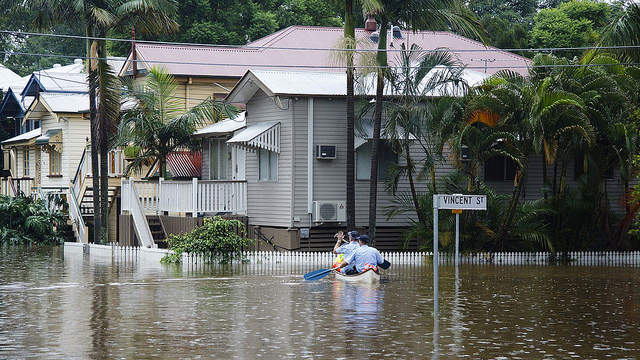Risk communication: talking at or talking with communities?
Posted By
Paul Barnes
on July 20, 2016 @ 11:00

Early warnings and communication with at-risk communities before and during crises have been central to recent post-disaster evaluations in Australia. Effective risk communication ideally results from engagement with those communities before, during and after emergencies and involving them in the discussion on choices about a range of safety and wider disaster mitigation options.
A key finding from the recent review into the Waroona bushfire in Western Australia noted inconsistencies in the timing of community warnings. Similar issues were raised in the review of the Wye River–Jamieson Track fire in Victoria. That review specifically referenced the need for timely updates to operational ‘risk maps’ as well as information and data logging systems supporting operational decision-making, resource activation and allocation.
While early warnings and effective communication are important for bushfire emergencies, they become even more critical in the case of emergencies such as the 2014 Hazelwood mine fire in Victoria because of the acute and longer-term effects on communities.
With fires blazing for 45 days, Hazelwood was a complex emergency. It involved a series of connected elements: embers from a bushfire triggering a smouldering fire in an open cut coal mine; a near continuous response from both Victorian Emergency Services with support from interstate fire services; health and safety exposures for fire fighters; and environmental exposures and an ongoing public health emergency for residents of Morwell and surrounding areas.
Effective communication needs for such events are seldom addressed effectively with ‘by the book’ solutions. It needs to go beyond the contexts of warnings and directives to evacuate as is often required in many bushfire or flooding scenarios where acute loss of life is of a prime concern.
The 2015 Productivity Commission’s (PC) report on natural disaster funding arrangements noted that ‘governments can also do better in terms of policy and practice that allow people to understand natural disaster risks’ and that ‘Information is critical to understanding and managing natural disaster losses.’ At face value, an assumption in the PC report is that just being better at communication and passing on information will increase public understanding of community safety and resilience.
The experience of living through complex emergencies that challenge the safety and wellbeing of all impacted is particularly disruptive to community cohesiveness and viability. Those experiences can be difficult for institutions to fully understand and engage with. There’s established evidence that it takes more than just better communication to address community needs in the face of danger from natural and technical hazards. Effective community engagement needs to sustain trust and credibility of the agencies providing the information.
In cases where there may be a trust deficit between agencies and communities merely providing generic assurances about safety and discounting the potential environmental exposures to communities-at-risk may be less effective.
In an open and candid environment, communities may want to know about issues ranging from concerns about the health effects from inhalation of potentially dangerous gases, a mine fire that proved difficult to control, and the results of environmental contamination monitoring and predictions about potential health impacts. Even though detail on some or all of these points may be uncertain.
In August 2014 a Board of Inquiry into the Hazelwood Fire recommended a number of improvements for meaningful engagement with the public, in particular ensuring emergency response agencies have—or have access to—the capability and resources needed for effective and rapid public communication, and a coordinated approach to the use of social media by government during emergencies.
A December 2015 Report on status of the implementation of those recommendations confirmed that most suggestions hadn’t yet been finalised.
The wide-spread use of Web2 platforms has changed how the public relies on governments or established authorities for information on danger or safety during emergencies. The public have reached the point where they’re not only informing themselves (by sharing information, opinion and experiences), but are reversing conventional risk communication flows by providing ‘on-the-ground’ information back to government and first response agencies.
Significant spikes in social media use by individuals and communities have been noted among both Australian and international communities impacted by natural disasters, as has use of crowd-sourced data in crisis mapping by official disaster response agencies.
But when and how should government institutions involved in complex emergencies (like Hazelwood) engage with constituents? While official reviews indicate government awareness of the importance of sustained community engagement, time will tell if Victorian authorities can effectively implement key capabilities into emergency response agencies.
Australian response agencies also need to make better and consistent use of crowd sourced data, with suitable checks on the accuracy and usefulness of any useful information, logging its receipt and use (or non-use) along with archival preservation.
Ultimately, governments need to understand that communities aren’t passive consumers of information and can also provide valuable information from the ground as contributions to official decision-making on response options.
A key challenge for government is how to reap the benefits of more openness in engaging communities before and during emergencies to both share official knowledge and access public knowledge.
Paul Barnes is a senior analyst at ASPI.
Article printed from The Strategist: https://www.aspistrategist.org.au
URL to article: https://www.aspistrategist.org.au/risk-communication-talking-talking-communities/
[1] review into the Waroona bushfire: http://www.parliament.wa.gov.au/publications/tabledpapers.nsf/displaypaper/3914260a65b2e61b817c974a48257fdb0035835a/$file/4260.pdf
[2] review of the Wye River–Jamieson Track fire: http://www.igem.vic.gov.au/home/reports+and+publications/reports/report+review+of+the+initial+response+to+the+2015+wye+river+jamieson+track+fire
[3] Hazelwood: http://report.hazelwoodinquiry.vic.gov.au/executive-summary/recommendations/recommendations-state
[4] Productivity Commission’s (PC) report: http://www.pc.gov.au/inquiries/completed/disaster-funding/report/disaster-funding-volume1.pdf
[5] established evidence: http://eprints.qut.edu.au/606/
[6] recommended: http://report.hazelwoodinquiry.vic.gov.au/recommendations
[7] Report: http://www.dpc.vic.gov.au/images/documents/Hazelwood_Mine_Fire_Inquiry_Implementation_2015_Annual_Report.pdf
[8] Significant spikes in social media use: http://mappingonlinepublics.net/category/crisis-2/
[9] crowd-sourced data in crisis mapping: http://theconversation.com/crowdsourced-crisis-mapping-how-it-works-and-why-it-matters-7014
 Print This Post
Print This Post